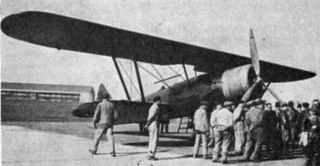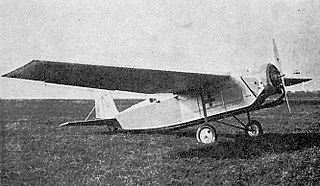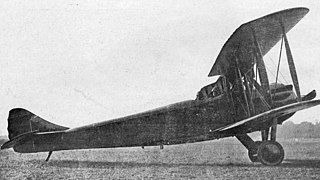
The Potez 37 was a two-seat, long range reconnaissance aircraft built to compete for a French government contract. It flew in mid-1930 but did not win the competition, so only two were completed.
The Potez 26 was a single seat fighter aircraft designed and flown in France in the mid-1920s. It did not reach production.

The Potez 40 was a French three-engine, braced high-wing monoplane designed and built in response to a French government programme for colonial transport and policing aircraft duties.
The Potez 27 was a French reconnaissance biplane first flown in 1924. 175 were operated by the Polish Airforce, most built in Poland by PWS under licence. Others went to Romania, where they were also used as light bombers.
The Caudron C.251 Et-2 was a French tandem seat, open cockpit biplane designed as an intermediate trainer and built in 1931. It did not go into production.

The Les Mureaux 3 C.2 and Les Mureaux 4 C.2 were French two seat, parasol winged fighters, flown in 1927-8, which differed only in their engines. They were developed into near identical army co-operation types, the ANF Les Mureaux 130 A.2 and ANF Les Mureaux 131 A.2, in 1929-31.
The Peitz 101, aka Peitz Avionette, was a French, amateur-built, all-metal light aircraft, first flown during the winter of 1931–32.
The Weymann W-100, Weymann CTW-100 or Weymann W-100 RBL was a French three seat observation aircraft with a position for the observer within its partially glazed fuselage. Only one was built.

The Potez 50 or Potez 50 A2 was a French two seat military multi-rôle aircraft, first flown in 1931. It did not go into service but seven variants using five different engines were produced, one of them setting several speed with useful load records and another, the Potez 506, setting three altitude world records.

The Wibault 260 R.2 was a contender for a French government contract for a long range, two seat reconnaissance aircraft, issued in 1928. There were eight prototypes in the 1931-2 contest and the Wibault was not selected for production.

The Nieuport-Delage NiD 580 R.2 was a contender for a French government contract for a long range, two seat reconnaissance aircraft, issued in 1928. There were eight prototypes in the 1931-2 contest and the NiD 580 was not selected for production.
The Kellner-Béchereau 23 was a French two seat cabin touring aircraft, built in 1932. Its wing was constructed in a novel way. Only one was completed.

The Guillemin JG.40 was designed and built to meet a French government requirement for a small air ambulance capable of operating in the colonies. Two were completed and performed well but the JG.40 did not reach production.

The Guillemin JG.10 or Blériot-Guillemin JG.10 was a French two seat touring aircraft, designed to be as simple and safe to fly and maintain as a car, with similar facilities, as well as provision for parachutes.
The CPA 1 was a French twin-engined, parasol-winged bomber designed and built in the mid-1920s.
The Muniz M-5 was the first of Antonio Guedez Muniz's aircraft designs to fly; soon afterwards he became the first Brazilian to design an aircraft which reached series production. The sole example of the M-5, built while he was a student in France by Caudron, was a low wing cabin tourer or military liaison aircraft.

The Albert A-10 was a four-seat French transport aircraft which could be rapidly converted into an air ambulance. Two or three examples were built between 1929 and 1932, using at least two different engines, but neither variant reached production.

The Tampier Avion-Automobile was a French roadable aircraft designed and built by René Tampier in 1921. Only two were built.





















